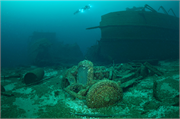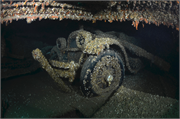Six miles east of Sturgeon Bay Canal, Lake Michigan
| Historic Name: | Lakeland Shipwreck (Steam Screw) |
|---|---|
| Reference Number: | 15000403 |
| Location (Address): | Six miles east of Sturgeon Bay Canal, Lake Michigan |
|---|---|
| County: | Door |
| City/Village: | Sturgeon Bay |
| Township: |
| Lakeland Shipwreck (Steam Screw) Six miles east of Sturgeon Bay Canal, Lake Michigan Sturgeon Bay, Door County, Wisconsin Launched: 1886 Sank: 1924 The Lakeland represents multiple eras of ship construction and use on the Great Lakes. She began as a bulk freighter in 1886, was converted to a passenger steamer in 1910; and finally was converted to a car carrier in 1920. In her first incarnation as the Cambria, she was only the second GIW freighter built with steel hull plates, and was the first vessel on the Great Lakes powered by a triple expansion steam engine. After her conversion to a car carrier in 1920, the Lakeland became associated with the early development of the Great Lakes region’s burgeoning automotive industry. Much of the Lakeland’s enduring fame stems from the circumstances of her sinking, the novel investigation of the wreck, and the lengthy court case that followed. The 1924 “Lakeland disaster” as some newspapers dubbed it, was one of the earliest Great Lakes losses to actually be photographed in the process of going down. The vessel had been suffering from persistent but manageable leaks and when rough seas threatened during a return trip, the captain decided to bring her into the Sturgeon Bay Canal to wait out the storm. The Lakeland had left Chicago on 2 December 1924 when she encountered heavy seas on Lake Michigan north of Chicago and the steel plates buckled, causing a leak. The minor leak worsened after the ship’s departure from the Sturgeon Bay canal. At 10:00 AM, a lookout at the Sturgeon Bay Coast Guard station observed the Lakeland in apparent distress, and at 11:30 AM, the Lakeland abruptly went down. The entire crew of the Lakeland escaped, but she took her cargo of automobiles to the bottom of the lake. Observers reported that her stern went under first, and the hull probably “telescoped” or broke in two. The Lakeland currently lies at the bottom of Lake Michigan underneath 205 feet of water. Although broken in half, the site retains excellent archaeological integrity, and sites such as the Lakeland present a rare opportunity to study and learn about historic steel-hull ship construction, and how these vessels were used in the bulk cargo, passenger, and package freight trades. State and federal laws protect this shipwreck. Divers may not remove artifacts or structure when visiting this shipwreck site. Removing, defacing, displacing or destroying artifacts or sites is a crime. More information on Wisconsin's historic shipwrecks may be found by visiting Wisconsin's Great Lakes Shipwrecks website. |
| Period of Significance: | 1886-1925 |
|---|---|
| Area of Significance: | Archeology/Historic - Non-Aboriginal |
| Area of Significance: | Maritime History |
| Area of Significance: | Commerce |
| Area of Significance: | Engineering |
| Area of Significance: | Science |
| Applicable Criteria: | Event |
| Applicable Criteria: | Information Potential |
| Historic Use: | Transportation: Water-Related |
| Architectural Style: | Other |
| Resource Type: | Site |
| Architect: | Globe Iron Works Company |
| Historic Status: | Listed in the State Register |
|---|---|
| Historic Status: | Listed in the National Register |
| National Register Listing Date: | 07/07/2015 |
| State Register Listing Date: | 05/16/2014 |
| Number of Contributing Buildings: | 0 |
|---|---|
| Number of Contributing Sites: | 1 |
| Number of Contributing Structures: | 0 |
| Number of Contributing Objects: | 0 |
| Number of Non-Contributing Buildings: | 0 |
| Number of Non-Contributing Sites: | 0 |
| Number of Non-Contributing Structures: | 0 |
| Number of Non-Contributing Objects: | 0 |
| National Register and State Register of Historic Places, State Historic Preservation Office, Wisconsin Historical Society, Madison, Wisconsin |



